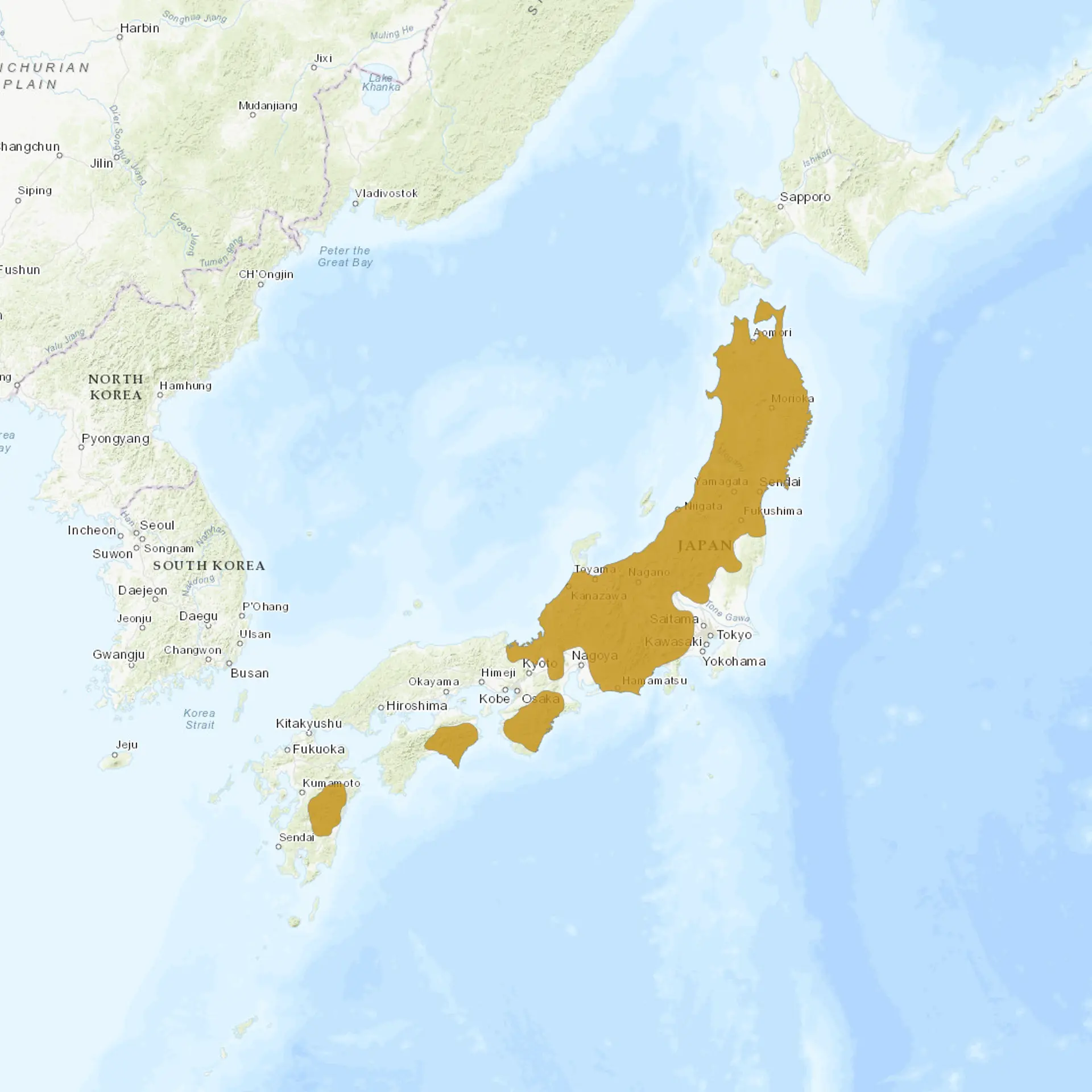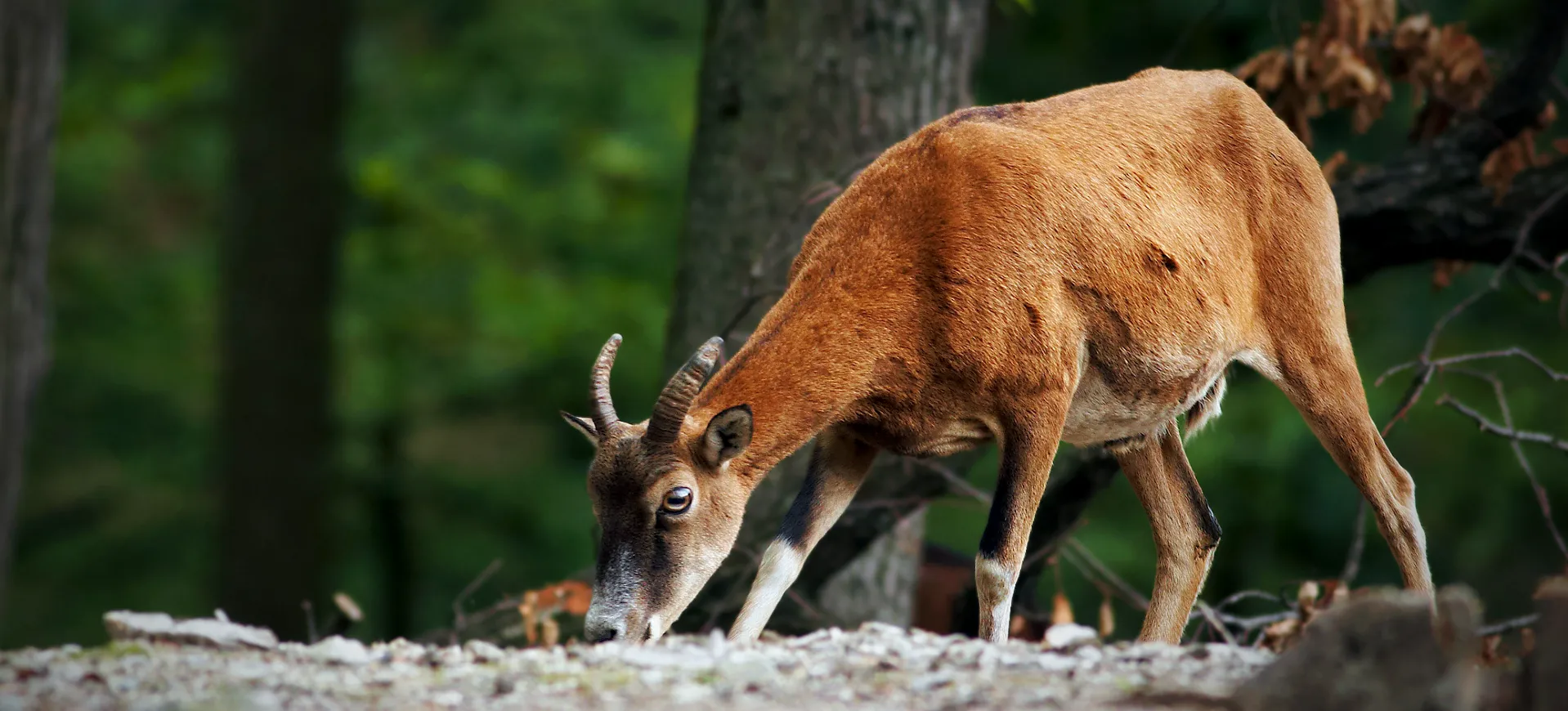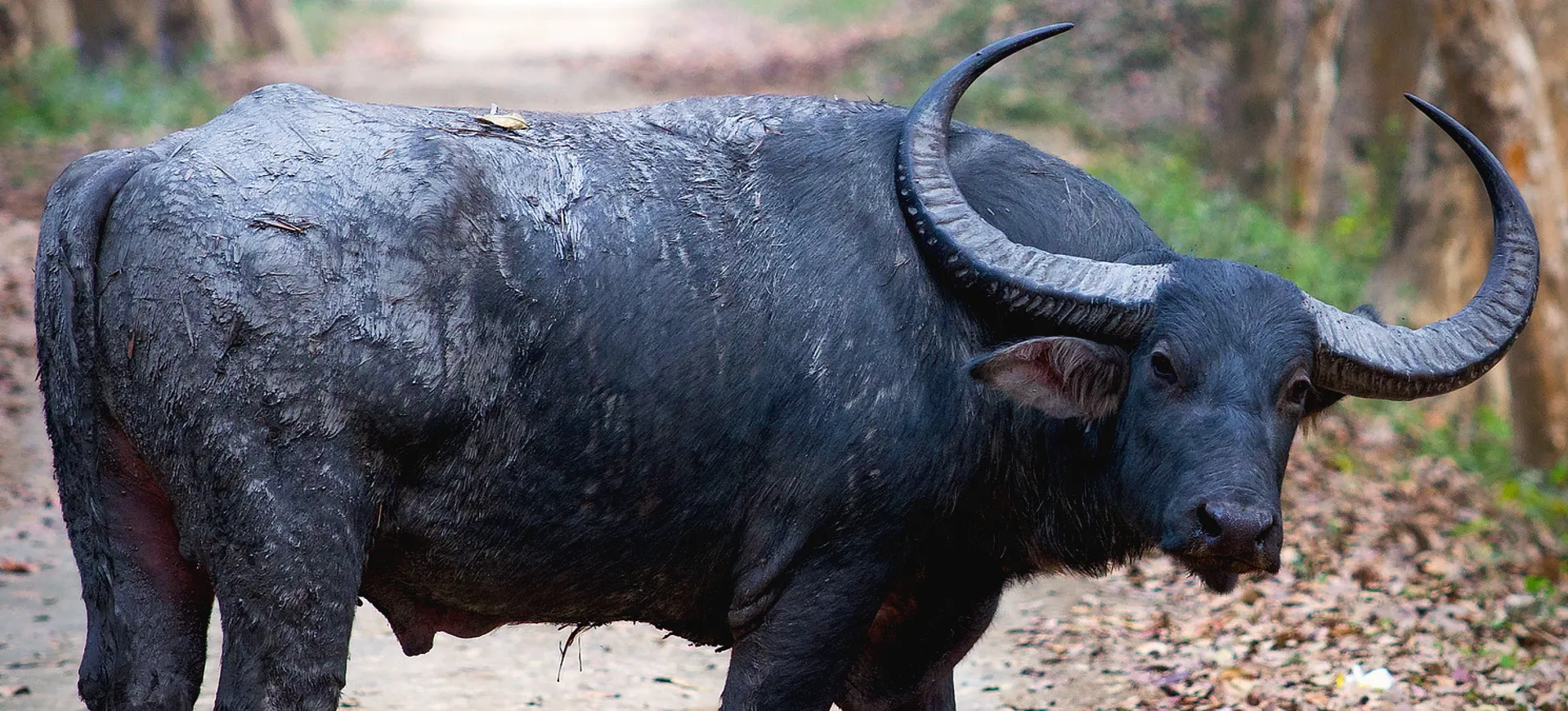Overview
The Japanese Serow (Capricornis crispus) is a goat-antelope species native to Japan’s dense forests and mountainous regions, particularly on the islands of Honshu, Shikoku, and Kyushu. These animals have a stocky build and are covered in dense, dark fur, with males and females sporting small, backward-curved horns. Japanese Serows are highly territorial and solitary animals, although they can occasionally be seen in pairs during the breeding season. Once endangered, they are now a protected species in Japan, with stable populations largely due to conservation efforts and legal protections.
Japanese Serows are known for their agility and sure-footedness, often found navigating steep, forested hillsides where they feed on various vegetation. Their diet primarily consists of leaves, shoots, acorns, and other forest plant materials, and they play a crucial role in maintaining the balance of forest ecosystems. These herbivores are active throughout the day, preferring early morning and late afternoon hours for feeding, and they are well adapted to Japan’s tropical climates. The Japanese Serow is often seen as a symbol of Japanese wildlife conservation and is even designated as a “special nature” monument” in Japan.
The”Japanese Serow’s dense tSerow’se allows it to survive in various forest habitats, from cool temperate forests to more subtropical areas. Their coloration, ranging from gray to black with lighter patches on the throat, helps them blend into their forested surroundings, making them difficult to spot. Despite their relatively small stature compared to other wild ungulates, they are formidable defenders of their territory, using their sharp horns and aggressive behavior to ward off intruders. Today, the Japanese Serow is a conservation success story, with its population thriving under protection, though habitat loss and fragmentation remain long-term concerns.
Taxonomy
Kingdom
Phylum
Class
Order
Family
Genus
Species
Type
Current distribution:
The Japanese Serow is found only in Japan, with populations distributed across Honshu, Shikoku, and Kyushu islands. They are most abundant in central and northern Honshu, where conservation efforts and legal protections have allowed their populations to rebound. In the past, overhunting and habitat destruction led to a severe decline in their numbers, but they are now protected under Japanese law, leading to population recovery. Today, Japanese Serows can be found in protected forest reserves and areas of secondary growth that have regenerated after human activity.
Their range is fragmented, as urbanization and agricultural expansion have reduced the availability of continuous forested habitat. However, the species is now considered stable, with approximately 100,000 individuals in the wild. They are often found near rural and mountainous areas, where conservation zones have been established to protect their habitat. Continued management is necessary to ensure their populations remain stable, particularly as human development encroaches on their forest homes.
Physical Description:
The Japanese Serow is a medium-sized mammal, standing about 31-35 inches (80-90 cm) at the shoulder and weighing between 66-110 lbs (30-50 kg). Its dense, coarse fur varies from black to dark gray, with lighter gray or white patches on the throat, chest, and lower legs, providing camouflage in its forested habitat. Both males and females have short, backward-curving horns that can grow up to 4-6 inches (10-15 cm), which they use for defense and territorial disputes. Their face has a long, slender snout, and their large, expressive eyes are well adapted for spotting movement in the dense undergrowth.
Japanese Serows are stocky and muscular, with short, strong legs that allow them to navigate their forest habitats’ steep, rocky terrain. Their hooves are split and specially adapted to provide traction on rocky surfaces, giving them agility in climbing and descending slopes. Their thick coat provides insulation during the cold winter months, especially in the higher elevations of their range. The overall body shape is compact and built for endurance rather than speed, which suits their grazing lifestyle in dense forests and rough terrain.

Lifespan: Wild: ~15 Years || Captivity: ~20 Years

Weight: Male & Female: 66-110 lbs (30-50 kg)

Length: Male & Female: 47-51 in (120-130 cm)

Height: Male & Female: 31-35 in (80-90 cm)

Top Speed: 22 mph (35 km/h)
Characteristic:
Native Habitat:
The Japanese Serow is native to Japan’s forests, particularly on the islands of Honshu, Shikoku, and Kyushu. It inhabits dense, temperate forests, including broadleaf and mixed coniferous forests, with ample cover and food sources. The species prefers steep, rocky terrain within these forests, which protects it from predators and competition with other herbivores. Japanese Serows are found at elevations ranging from 600 to 6,000 feet (180 to 1,800 meters), depending on the region and season.
These forested areas are rich in biodiversity, and the serow plays an important role in maintaining the ecological balance of these ecosystems. They are often found in secondary-growth forests, which offer a variety of plants that thrive in disturbed or regenerating environments. As a solitary and territorial species, the Japanese Serow typically occupies a well-defined home range that provides shelter, food, and access to water. Habitat fragmentation due to human activities remains challenging, though conservation efforts have helped preserve many of the forests they depend on.
Climate Zones:
Biogeographical Realms:
Continents:
Countries:
Diet:
Diet & Feeding Habits:
Japanese Serows are herbivores that feed primarily on vegetation, including leaves, shoots, and shrubs that grow in dense forest habitats. They are selective browsers, meaning they choose specific plants based on availability and nutritional content. During the autumn months, they consume large quantities of acorns and chestnuts, which are abundant and rich in energy, helping them build fat reserves for winter. When food is scarcer in winter, they turn to evergreen plants and bark, using their strong molars to strip bark off trees.
Their feeding behavior plays an important ecological role in forest dynamics by controlling plant growth and dispersing seeds through feces. Japanese Serows are most active during dawn and dusk when they forage for food, resting or sheltering in thick underbrush for the rest of the day. They must consume large amounts of vegetation daily to meet their energy needs, particularly during colder months when high-energy foods are essential for survival. Water is usually obtained from dew on plants or nearby streams, as they live in moist forest environments.
Mating Behavior:
Mating Description:
The Japanese Serow follows a monogamous mating system, with pairs often forming during the breeding season. The mating season typically occurs between September and November, during which males and females engage in courtship behaviors, such as scent marking and vocalizations. Males defend their territories aggressively from other males during this time, using their horns and physical displays to establish dominance. Once mating occurs, the pair remains together for a short period, after which they return to their solitary, territorial behaviors.
Gestation lasts about 210-230 days, with the female giving birth to a single offspring, typically between May and July. The newborn serow, known as a kid, is well-developed and can stand and follow its mother within hours of birth. The mother provides care and protection to the young for several months, after which the juvenile becomes more independent but may remain within the mother’s territory for up to a year. Japanese Serows are viviparous, with live births, and reproductive success depends heavily on the availability of food and shelter within their habitat.
Reproduction Season:
Birth Type:
Pregnancy Duration:
Female Name:
Male Name:
Baby Name:
Social Structure Description:
Japanese Serows are primarily solitary animals, with individuals maintaining and defending their territories year-round. Both males and females are territorial, using scent markings and vocalizations to communicate their presence and ward off intruders. During the breeding season, males and females come together briefly for mating but generally return to solitary behavior afterward. Territorial disputes between males can be aggressive, involving head-butting and chasing, although these encounters are relatively rare outside of the mating season.
Females tend to be more tolerant of their offspring, and young serows may remain in their mother’s territory for up to a year before dispersing to find their territory. Social bonds between mother and offspring are strong during the first few months after birth, but these weaken as the young serow matures. Individual communication is often subtle, relying on body language and scent rather than vocalizations. Japanese Serows are highly vigilant and use their keen senses to detect potential environmental threats.
Groups:
Conservation Status:
Population Trend:
The population of Japanese Serow has recovered significantly from its earlier decline due to hunting and habitat loss. Currently, an estimated 100,000 individuals are in the wild, primarily on the islands of Honshu, Shikoku, and Kyushu. Still, studies have not been conducted to assess the population accurately. Strict legal protections and the establishment of conservation zones have been instrumental in stabilizing the population, which was once on the verge of extinction. The Japanese government has designated the species as a “special natural monument,” granting it legal protection and making hunting illegal.
Despite their stable population, habitat fragmentation due to urbanization and agricultural development continues to be a threat. The species is particularly vulnerable in areas where forest habitats are not well-connected, limiting their ability to move between territories. However, Japanese Serows have shown some adaptability to human-modified landscapes, occasionally venturing into rural areas. Ongoing conservation efforts focus on maintaining habitat corridors and monitoring population health to ensure continued stability.
Population Threats:
The primary threats to Japanese Serow populations are habitat loss and fragmentation caused by urban development, deforestation, and agricultural expansion. Although hunting is now illegal, poaching can still occur, particularly in areas where enforcement is lacking. Habitat fragmentation limits the availability of suitable territories for serows, leading to increased competition and difficulty finding food and mates. In some regions, conflict with humans arises when serows venture into agricultural areas and damage crops.
Climate change threatens their habitat, potentially altering the structure and composition of the forests they rely on for food and shelter. In addition, invasive plant species introduced through human activity can disrupt the natural balance of forest ecosystems, affecting the availability of the plants they feed on. Conservationists continue to work on preserving and restoring forest habitats, but human encroachment remains an ongoing challenge. Education campaigns and stricter enforcement of anti-poaching laws are critical for mitigating these threats.
Conservation Efforts:
The Japanese Serow is a conservation success story, thanks to strict legal protections and habitat conservation initiatives. In the mid-20th century, the species was on the brink of extinction due to overhunting and habitat loss. Today, it is protected by Japanese law as a “special natural monument,” making hunting illegal and designating protected areas where serows can thrive. Conservation zones have been established in many parts of their range, particularly in national parks and forest reserves, where their habitat is carefully managed.
In addition to legal protections, conservation efforts have focused on habitat restoration and maintaining forest corridors that connect isolated populations. Public awareness campaigns have been launched to educate local communities about protecting the Japanese Serow and reducing human-wildlife conflict. Research on population dynamics, habitat use, and the impact of human activities on serow populations is ongoing to inform management strategies. Although their populations are stable, continued conservation efforts are necessary to ensure the species’ long-term survival.
Additional Resources:
Fun Facts
- The Japanese Serow is the only species of Serow found in Japan and, due to its ancient lineage, is considered a “living fossil.”
- It is designated a “special natural monument” in Japan, giving it strict legal protection.
- Serows are highly territorial and aggressively defend their home ranges using scent marking and physical displays.
- They are excellent climbers, able to easily navigate steep, rocky terrain thanks to their specialized hooves.
- Japanese Serows are often depicted in Japanese folklore and culture as symbols of wilderness and conservation.
- The species plays an important role in forest ecosystems by controlling the growth of certain plant species through selective browsing.
- Unlike many other ungulates, the Japanese Serow is active throughout the year and does not migrate seasonally.
- Both males and females have small, backward-curving horns used for defense and territorial disputes.
- Japanese Serows were once heavily hunted for meat and hides, but hunting is now illegal.
- They are one of the few large mammals endemic to Japan and are viewed as a conservation success story in the country.



















































































